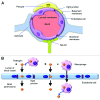Molecular mechanisms of cryptococcal meningitis
- PMID: 22460646
- PMCID: PMC3396696
- DOI: 10.4161/viru.18685
Molecular mechanisms of cryptococcal meningitis
Abstract
Fungal meningitis is a serious disease caused by a fungal infection of the central nervous system (CNS) mostly in individuals with immune system deficiencies. Fungal meningitis is often fatal without proper treatment, and the mortality rate remains unacceptably high even with antifungal drug interventions. Currently, cryptococcal meningitis is the most common fungal meningitis in HIV-1/AIDS, and its disease mechanism has been extensively studied. The key steps for fungi to infect brain and cause meningitis after establishment of local infection are the dissemination of fungal cells to the bloodstream and invasion through the blood brain barrier to reach the CNS. In this review, we use cryptococcal CNS infection as an example to describe the current molecular understanding of fungal meningitis, including the establishment of the infection, dissemination, and brain invasion. Host and microbial factors that contribute to these infection steps are also discussed.
Figures

References
Publication types
MeSH terms
Grants and funding
LinkOut - more resources
Full Text Sources
Other Literature Sources
